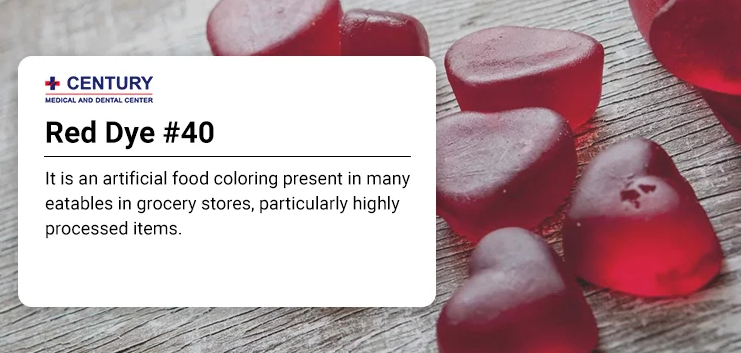BOURSESSENEGAL – In recent years, food labeling has gained significant attention, and many consumers have started to question the ingredients in their favorite snacks and beverages. One of the most frequently discussed additives is Red 40. If you’ve ever wondered, “What is Red 40?” you’re not alone. This synthetic dye, also known as Allura Red AC, is prevalent in many foods and drinks. In this blog post, we’ll delve into what Red is, its uses, potential health effects, and alternatives you might consider.
What Is Red 40 and Its Common Uses?
Red 40 is a synthetic dye derived from petroleum. It’s one of the most commonly used food colorants in the United States. Manufacturers utilize it to enhance the appearance of various products, making them more visually appealing. This bright red dye appears in candies, soft drinks, baked goods, and even some dairy products.
Why Is Red 40 So Popular?
The popularity of Red can be attributed to several factors:
- Vibrancy: It provides a striking red hue, which can make products more attractive to consumers.
- Stability: Red maintains its color well, even under heat and light, making it ideal for processed foods.
- Cost-Effective: Using synthetic dyes is often cheaper than using natural alternatives.
The Controversy Surrounding Red 40
While Red is approved for use by the Food and Drug Administration (FDA), it has faced scrutiny. Many people express concerns about its safety and potential side effects. Let’s explore some of these worries in detail.
Potential Health Effects of Red 40
Allergic Reactions and Sensitivities
Some individuals report allergic reactions to Red . Symptoms can include hives, swelling, and gastrointestinal discomfort. For those with sensitivities, avoiding products containing this dye becomes essential.
Hyperactivity in Children
Numerous studies have investigated the link between artificial colors, including Red , and hyperactivity in children. Some research suggests that certain additives can exacerbate symptoms in children with Attention Deficit Hyperactivity Disorder (ADHD). Although findings are mixed, parents often choose to limit their children’s intake of synthetic dyes.
Regulatory Stance on Red 40
The FDA monitors food additives, including Red . The agency has deemed it safe for consumption, provided it meets specific guidelines. However, the controversy persists, with some consumer advocacy groups pushing for stricter regulations.
How to Identify Red 40 in Products
To avoid Red , consumers should read ingredient labels carefully. Here are some tips:
Common Names and Synonyms
Red 40 might appear under various names, including:
- Allura Red AC
- E129 (in Europe)
- FD&C Red No. 40
Products Likely to Contain Red 40
While you might not find it in every product, some categories are more likely to include Red 40:
- Candy: Gummy bears, fruit snacks, and lollipops often use this dye to achieve a vibrant look.
- Beverages: Many sodas and flavored drinks contain Red for color enhancement.
- Processed Foods: Many packaged snacks and breakfast cereals use this dye to appeal to children.
Natural Alternatives to Red 40
As awareness about food additives grows, many brands are exploring natural alternatives. If you’re looking to avoid synthetic dyes, consider these options.
Natural Colorants
Here are some natural substitutes for Red 40:
- Beet Juice: Provides a similar red hue and is derived from a natural source.
- Pomegranate Extract: Adds both color and flavor without synthetic additives.
- Annatto: Sourced from the seeds of the achiote tree, this natural dye can impart a reddish hue to foods.
Brands That Use Natural Alternatives
Several brands are committed to using natural ingredients. Look for those that proudly display “no artificial colors” on their packaging. They often appeal to health-conscious consumers seeking transparency in food labeling.
Making Informed Choices
In a world increasingly focused on health and wellness, understanding what goes into your food is crucial. Here are some strategies for making informed choices.
Educate Yourself
Stay updated on food additives and potential health impacts. Many resources are available online, including articles, studies, and consumer advocacy sites. Knowledge empowers you to make decisions that align with your health goals.
Shop Mindfully
When shopping, prioritize products with clear, transparent labeling. Avoid items with long ingredient lists filled with unrecognizable names. Instead, choose brands that emphasize quality ingredients.
Consult with Healthcare Professionals
If you have specific concerns about Red or other food additives, consider discussing them with a healthcare professional. They can provide personalized advice based on your health needs.
Conclusion: Navigating the Red 40 Debate
In summary, understanding what Red is can help you navigate the complexities of food labeling and additives. While it remains a popular choice among manufacturers, its safety continues to be a topic of debate. By educating yourself and making mindful choices, you can take control of your diet and well-being.
As you read labels and choose products, remember that knowledge is power. Whether you decide to embrace or avoid Red 40, being informed will always serve you well in your dietary choices
REFERENCE : https://www.health.com/



